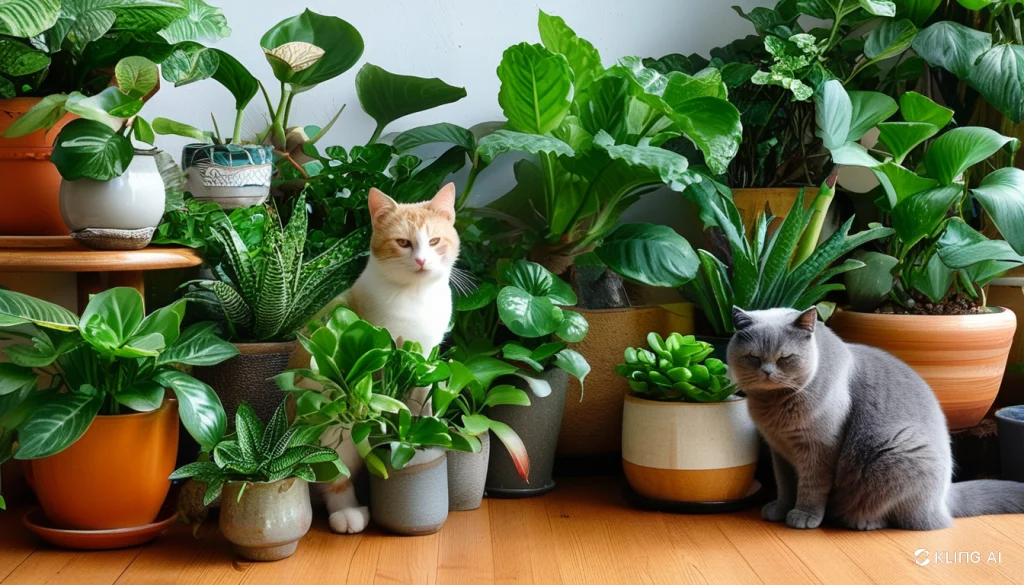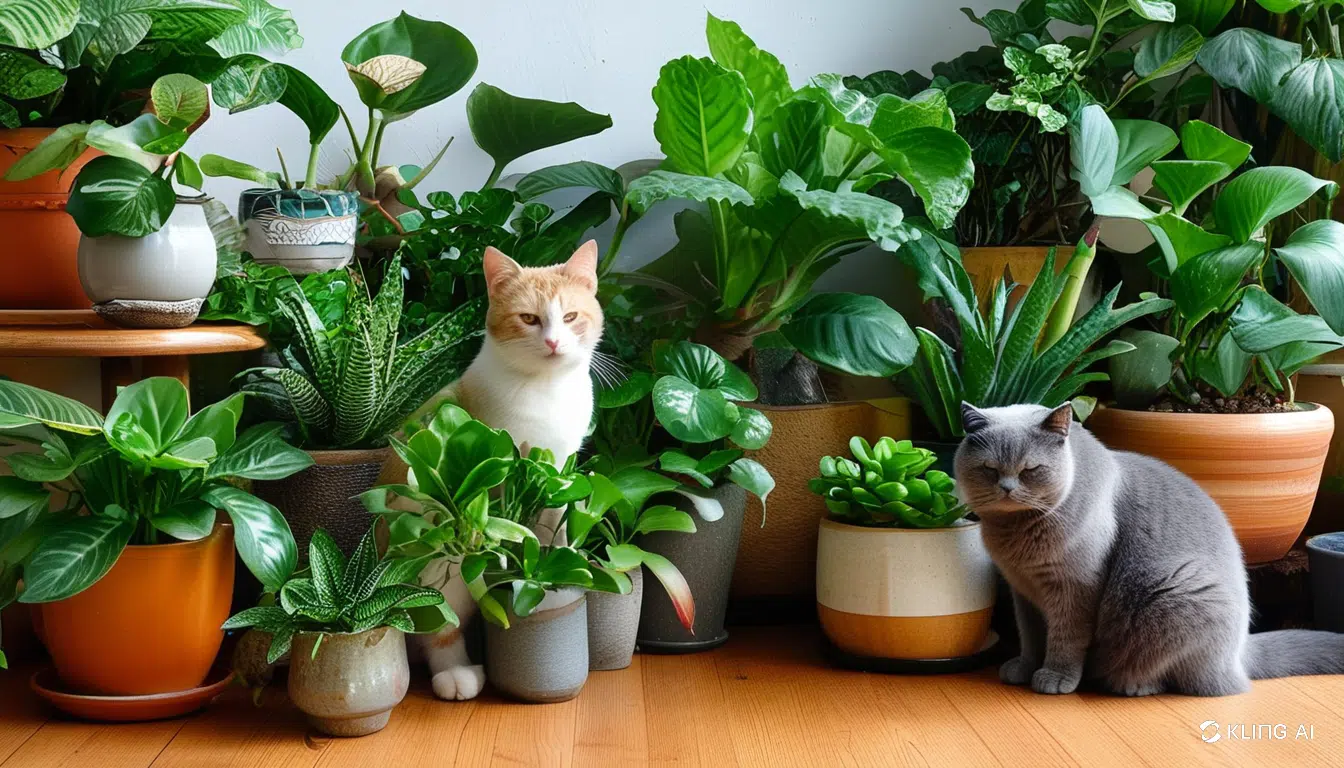Views: 281
Table of Contents
Introduction
This article explores Cat-safe houseplants that thrive in low light, providing tips on how to care for them and maintain a beautiful indoor environment that is safe for your feline friend.
Houseplants are a wonderful way to brighten up a home, adding a natural aesthetic while purifying the air. However, pet owners, especially cat parents, must be cautious about the types of plants they bring into their home. Many houseplants, while beautiful, can be toxic to cats. In addition to safety, low-light conditions can present a challenge when selecting the right plants.

2. Why Certain Plants Are Unsafe for Cats
Common Toxic Houseplants
Many common houseplants, such as lilies, philodendrons, and pothos, are toxic to cats. These plants contain substances that can cause a range of symptoms, from mild irritation to severe poisoning. Lilies, for example, are highly toxic and can cause kidney failure in cats, while philodendrons can lead to oral irritation and vomiting.
How Cats React to Toxic Plants
Cats may experience symptoms like drooling, vomiting, difficulty breathing, and lethargy when exposed to toxic plants. Since cats often explore plants by chewing on leaves or digging in the soil, it’s important to be aware of what plants you’re introducing to your home.
3. Benefits of Cat-Safe Houseplants in Low Light
Air Purification
Many houseplants are known to purify indoor air by removing toxins and increasing oxygen levels. Plants such as the spider plant and Boston fern are effective at filtering out pollutants, making your home healthier for both you and your cat.
Mental Stimulation for Cats
Plants can also offer cats mental stimulation, mimicking their natural environment. Watching plants sway or batting at soft leaves can keep indoor cats entertained, offering sensory experiences that promote their well-being.
4. Best Cat-Safe Houseplants for Low Light
Spider Plant
The spider plant (Chlorophytum comosum) is one of the best houseplants for low light and is completely safe for cats. Its long, arching leaves add a graceful touch to any room, and it’s easy to care for in low light conditions.
Boston Fern
Boston ferns (Nephrolepis exaltata) thrive in lower light and add lush greenery to your home. Safe for cats, they also work well as natural humidifiers, improving the air quality in your living space.
Cast Iron Plant
The cast iron plant (Aspidistra elatior) is as tough as its name suggests, able to survive in very low light and dry conditions. It’s a perfect option for cat owners who want a resilient and pet-safe plant.
Areca Palm
Areca palms (Dypsis lutescens) are beautiful, tall plants that tolerate low light. These palms are also cat-safe, making them an excellent choice for adding height and dimension to your indoor garden.
Calathea
Calathea plants, known for their stunning leaf patterns, are safe for cats and do well in low light. Their colorful foliage adds a vibrant pop to any room while ensuring your cat is not at risk.
5. How to Care for Houseplants in Low Light
Understanding Low Light Conditions
Low light doesn’t mean no light. It typically refers to rooms that don’t get direct sunlight or only receive filtered light. Understanding the specific needs of your plants will help them thrive.
Tips for Watering Low-Light Plants
Overwatering is one of the most common mistakes with low-light plants. Ensure the soil is dry before watering and be mindful of each plant’s moisture needs. Most low-light plants prefer to be slightly dry between watering.
Fertilizing in Low Light
Since low-light plants grow more slowly, they require less fertilization. Using a diluted, balanced fertilizer once a month during the growing season can help maintain their health.
Proper Placement and Care
Position your plants near windows that receive indirect light or in shaded corners where they can still benefit from ambient light. Rotate them regularly to ensure even growth.
6. Creating a Cat-Friendly Indoor Garden
Arranging Plants in Cat-Safe Areas
When designing your indoor garden, consider placing plants in areas where your cat is less likely to knock them over or chew on them. Hanging plants or placing them on high shelves can be a great solution.
Using Decorative Planters for Aesthetic Appeal
Decorative planters not only add style to your indoor garden but also help deter curious cats from digging in the soil. Consider using covered pots or placing stones on the surface of the soil to prevent unwanted digging.
7. Common Issues with Houseplants and Cats
Cats Digging in Soil
One common issue cat owners face is their cat digging in plant soil. To prevent this, consider using plant-safe deterrents like citrus peels or pinecones around the base of the plant.
Chewing Leaves and How to Discourage It
If your cat is prone to chewing leaves, providing alternative distractions like cat grass or toys can help. You can also try bitter-tasting sprays designed to deter cats from chewing plants.
8. Expert Insights
Veterinarian Insights on Plant Safety
Dr. Sarah Thompson, a veterinarian specializing in feline health, advises, “Choosing non-toxic plants is essential for cat owners. Cats are naturally curious, and it’s safer to assume they will explore any new addition to their environment.”
Botanist Recommendations for Low-Light Houseplants
Botanist Mark Johnson recommends low-maintenance plants such as the spider plant and cast iron plant for low light. “These plants thrive with minimal care and are perfect for pet owners who want to create a lush, cat-safe home.”
9. Future Trends in Cat-Safe Plants
Innovative Indoor Planting for Pet Owners
As the trend of pet-friendly homes grows, companies are developing innovative solutions like self-watering planters and cat-proof plant stands, making it easier than ever to care for plants while keeping them out of reach of curious cats.
New Varieties of Non-Toxic Plants
Breeders are working on developing new, attractive varieties of non-toxic plants that thrive in low light, catering to the increasing demand for pet-safe options.
10. Conclusion
Creating a cat-safe indoor garden in low-light conditions is not only possible but also beneficial for both your cat and your home environment. By choosing the right plants, like spider plants and Boston ferns, and following proper care techniques, you can enjoy the beauty of houseplants without compromising your cat’s safety.
11. FAQs
What Houseplants Are Poisonous to Cats?
Common toxic plants include lilies, philodendrons, and pothos. Always check the safety of a plant before bringing it home.
How Can I Tell if My Cat Has Eaten a Toxic Plant?
Signs of plant poisoning in cats include vomiting, drooling, difficulty breathing, and lethargy. Contact your vet immediately if you suspect poisoning.
How Can I Maintain Healthy Houseplants in Low Light?
Ensure your plants are in the right conditions, water them appropriately, and fertilize occasionally to support their growth in low-light environments.

